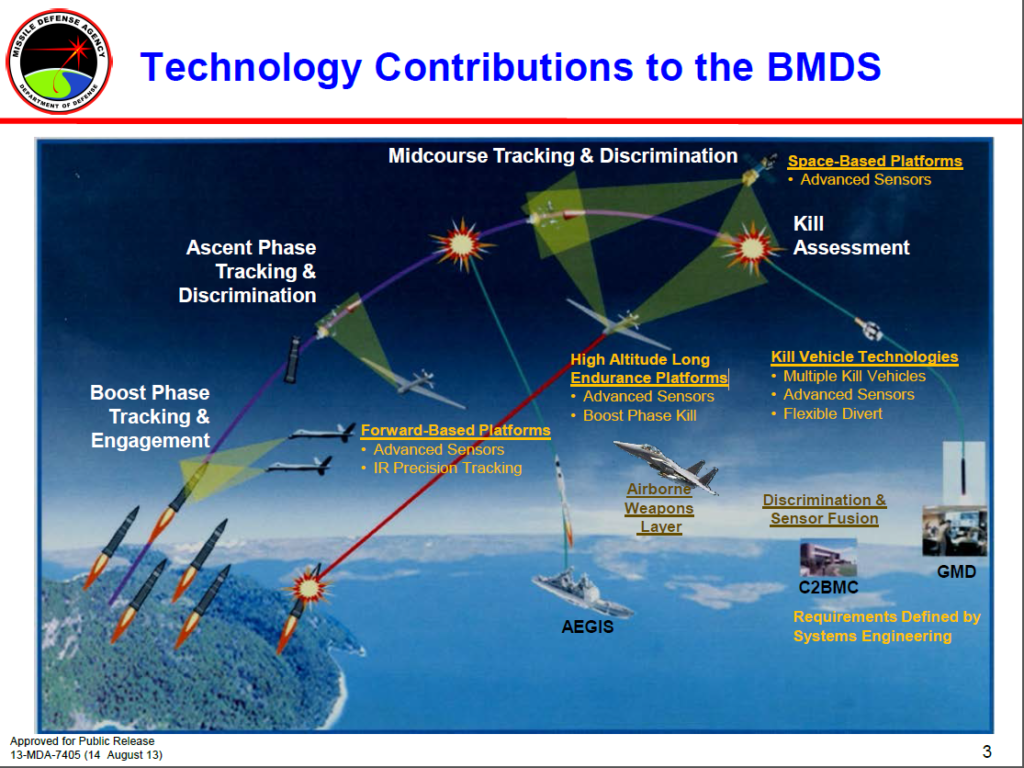“INITIAL OPERATIONAL DEPLOYMENT.—The Secretary of Defense shall ensure that an effective interim kinetic or directed energy boost phase ballistic missile defense capability is available for initial operational deployment as soon as practicable.” Section 1685, National Defense Authorization Act for 2018
We have known since the earliest studies of ballistic missile defense (BMD) systems, dating to the 1960 Project Defender studies by the Defense Department’s Advanced Research Projects Agency (DARPA), that the most effective time to shoot down an attacking ballistic missile is in its boost phase, while its rockets are still burning making it a highly visible, accelerating, vulnerable target, before it can release decoys and other countermeasures that make its warhead much more difficult to intercept in its “midcourse” phase, above the atmosphere in space.
Moreover, Project Defender identified the most effective way to accomplish such a defense would be from space, when the technology had advanced sufficiently to enable an affordable capability. Such a space-based defense would provide global defense coverage as could no other basing mode. Moreover, it would provide intercept opportunities in all an attacking ballistic missile’s phases of flight.
That technological advancement reached a most promising stage in the early 1990s, thanks to the vision of President Ronald Reagan’s Strategic Defense Initiative (SDI) that in 1983 for the first time in over a decade made it politically correct to consider how best to provide truly cost-effective defenses, including from space-based BMD systems.
Most prominent was “Brilliant Pebbles,” the first SDI concept to enter a formal Demonstration and Validation (DEMVAL) phase, as approved in late 1989 by the Pentagon’s Defense Acquisition Board (DAB).
However, the concept was not then “politically correct” and was sharply curtailed by congress in 1992 and completely scuttled in early 1993, when the Clinton administration cancelled all the related technology and dispersed its key technical investigators — and efforts to achieve the benefits of such an important capability ceased for the next quarter century.
To briefly review this history, click here for Historian Donald Baucomb’s “The Rise and Fall of Brilliant Pebbles,” which explains why space-based defenses were such a high priority during the SDI decade, between 1983 and 1993 — when, after the end of my watch as SDI Director, the Clinton administration “took the stars out of Star Wars” as Defense Secretary Les Aspin famously bragged.
Click here for my last week’s message that welcomed Congressional action in its National Defense Authorization Act for 2018 (NDAA 2018) — Section 1688, which directed the Defense Department again to seek a viable space-based defense capability. Hopefully, that legislation will again lead to building truly cost-effective space-based BMD systems that can intercept ballistic missiles in all phases of their flight.
This week, I want to address another welcome and more rapidly achievable NDAA 2018 companion provision, namely one again focused on intercepting ballistic missiles in their boost-phase. See Section 1685 below.
|
SEC. 1685. BOOST PHASE BALLISTIC MISSILE DEFENSE. (a) SENSE OF CONGRESS.—It is the sense of Congress that, if consistent with the direction or recommendations of the Ballistic Missile Defense Review that commenced in 2017—
(b) INITIAL OPERATIONAL DEPLOYMENT.—The Secretary of Defense shall ensure that an effective interim kinetic or directed energy boost phase ballistic missile defense capability is available for initial operational deployment as soon as practicable. (c) PLAN.—Together with the budget of the President submitted to Congress under section 1105(a) of title 31, United States Code, for fiscal year 2019, the Secretary of Defense shall submit to the congressional defense committees a plan to achieve the requirement in subsection (b). Such plan shall include—
|
We recognized during the SDI era, that such a “boost-phase intercept” capability also can be achieved by basing modes other than in space. We introduced programs to develop Unpiloted Aerial Vehicles (UAVs) as “less politically incorrect” platforms for launching interceptors to achieve a boost-phase defense capability.
Click here for my first High Frontier recollection almost four years ago of these “Raptor-Talon” efforts that also were scuttled by the Clinton administration — though development of the UAVs continued and significant capabilities were in fact demonstrated — but not in a BMD context, and certainly not as a platform for enabling boost-phase intercepts of attacking ballistic missiles. See below. And click here for my most recent High Frontier discussion of this important boost-phase intercept capability that could be made operational quickly today.
I recently joined with Dale Tietz — who managed SDI’s Raptor-Talon program a quarter century ago and subsequently has sought to revive those efforts to provide a boost-phase intercept capability — to write two pertinent Newsmax articles.
Click here for our first article that observed we must develop more cost-effective BMD systems to meet the demand that we “get on the right side of the cost curve” by reviving key SDI programs discarded a quarter century ago — including both Brilliant Pebbles and Raptor-Talon.
Click here for my second article recommending an airborne capability that more quickly can achieve a boost-phase intercept capability by employing the Advanced Medium-Range Air-to-Air Missile (AMRAAM) launched from U.S. Air Force and Navy fighter aircraft — and well as from allied fighter aircraft.
Finally, it should be understood that our Aegis BMD ships near North Korea can intercept ballistic missiles in their ascent phase, slightly after their rockets have burned out, as well as later in their flight trajectory during their midcourse phase in space. In 2009, the Navy’s first generation Standard Missile-3 IA interceptor was used to shoot down a dying satellite to protect citizens from toxic fuel expected if it reentered in-tact into the earth’s atmosphere.
Click here for my discussion of these impressive capabilities, which are implied in the following 2014 Missile Defense Agency (MDA) graphic. Note that space-based and airborne platforms indicated for advanced sensors and precision tracking could also be developed as interceptor platforms. And it is plausible that the Aegis air defense interceptors also can be adapted to shoot down ballistic missiles in their boost phase, provided the ships are near enough to the launch site of attacking ballistic missile.
Thus, the NDAA 2018 has clearly set stage to “Go back to the Future” by reviving concepts pioneered in the SDI era, now with much more advanced technology — that can provide many opportunities to intercept ballistic missiles throughout their full flight trajectory.
Will we do so? When??
Bottom Line.
Trump administration leaders need to make these possibilities happen ASAP! As argued last week, they should assure the on going Ballistic Missile Defense Review reaches an appropriate conclusion consistent with the introductory clause of NDAA 2018 Section 1688, related to space based interceptors by providing consistent directions or recommendations . . .
“If consistent with the direction or recommendations of the Ballistic Missile Defense Review that commenced in 2017, the Director of the Missile Defense Agency shall develop a space-based ballistic missile intercept layer to the ballistic missile defense system that is—regionally focused; (2) capable of providing boost-phase defense; and (3) achieves an operational capability at the earliest practicable date.”
My discussion this week strongly suggests that an effective boost phase ballistic missile defense capability can be provided quickly — initial from airborne platforms and next by space-based interceptors, which also can provide a global defense to intercept ballistic missiles in all their phases of flight.
Stay tuned . . .
What can you do?
Join us in praying for our nation, and for a rebirth of the freedom sought, achieved and passed to us by those who came before us.
Help us to spread our message to the grass roots and to encourage all “powers that be” to provide for the common defense as they are sworn to do.
Begin by passing this message to your friends and suggest they visit our webpage www.highfrontier.org, for more information. Also, please encourage your sphere of influence to sign up for our weekly e-newsletter.
Encourage them to review our past email messages, posted on www.highfrontier.org, to learn about many details related to the existential manmade and natural EMP threats and how we can protect America against them. I hope you will help us with our urgently needed efforts, which I will be discussing in future messages.
Click here to make a tax deductible gift. If you prefer to mail a check, Please send it to 500 North Washington Street, Alexandria, VA 22314.
E-Mail Message 171128
Please click here to read Past Weekly Updates!
Please help High Frontier continue this important and timely work!
Be sure to follow us on our Social Sites!
If you found this letter via our Social Sites, and you would like to subscribe, please click below!







